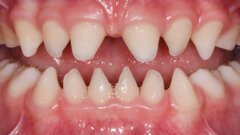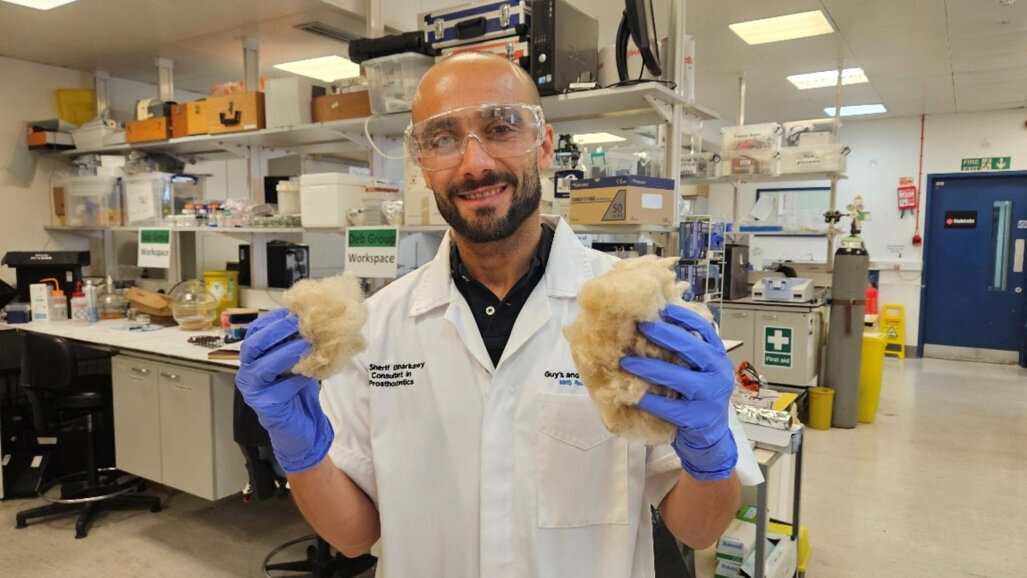The unexpected dental elixir is keratin. The study found that keratin can generate a dense mineral coating that closely mimics natural enamel when applied to a tooth’s surface and combined with minerals in the saliva. Unlike fluoride toothpastes, which can only slow the process of enamel erosion and loss, keratin has the potential to provide both structural repair and symptomatic relief by sealing dentinal tubules exposed during enamel loss.
In the study’s laboratory experiments, keratin treatment formed an enamel-like scaffold that continued to attract calcium and phosphate ions from saliva, enabling gradual enamel-like coating growth over time. In fact, the keratin coating outperformed conventional resin used in treatment of early caries, forming a layer five to six times harder.
The process by which keratin derived from wool and hair is transformed into an enamel-like substance that can be infused within a toothpaste or gel.
Speaking in a university press release, first author of the study Dr Sara Gamea, postdoctoral researcher at King’s College London, explained: “Keratin offers a transformative alternative to current dental treatments. Not only is it sustainably sourced from biological waste materials like hair and skin, it also eliminates the need for traditional plastic resins, commonly used in restorative dentistry, which are toxic and less durable. Keratin also looks much more natural than these treatments, as it can more closely match the colour of the original tooth.”
The keratin used in the study can be sustainably derived—from sources such as wool or waste human hair—offering an eco-friendly alternative to synthetic or toxic materials frequently employed in restorative dentistry. Reimagining hair clippings or similar biological waste as biomaterials aligns with growing trends in circular, sustainable healthcare innovations.
The researchers reported that keratin may soon be formulated into everyday toothpaste or a professionally applied gel for targeted enamel repair. Commercial products could feasibly be released within the next two to three years, pending studies on formulation, taste, safety and dosing, as well as clinical trials.
Commenting on the enormous potential such emergent techniques hold for public oral health, senior author Dr Sherif Elsharkawy, clinical lecturer in prosthodontics at King’s College London, stated: “We are entering an exciting era where biotechnology allows us to not just treat symptoms but restore biological function using the body’s own materials. With further development and the right industry partnerships, we may soon be growing stronger, healthier smiles from something as simple as a haircut.”
While experts not involved in the study have cautioned that the technology is in the early stages and still requires clinical validation, the potential of a cheap, abundant and biodegradable biomaterial to naturally repair tooth enamel may mark a transformative shift in preventive and restorative dentistry.
The study, titled “Biomimetic mineralization of keratin scaffolds for enamel regeneration”, was published online on 12 August 2025 in Advanced Healthcare Materials ahead of inclusion in an issue.



 Austria / Österreich
Austria / Österreich
 Bosnia and Herzegovina / Босна и Херцеговина
Bosnia and Herzegovina / Босна и Херцеговина
 Bulgaria / България
Bulgaria / България
 Croatia / Hrvatska
Croatia / Hrvatska
 Czech Republic & Slovakia / Česká republika & Slovensko
Czech Republic & Slovakia / Česká republika & Slovensko
 France / France
France / France
 Germany / Deutschland
Germany / Deutschland
 Greece / ΕΛΛΑΔΑ
Greece / ΕΛΛΑΔΑ
 Hungary / Hungary
Hungary / Hungary
 Italy / Italia
Italy / Italia
 Netherlands / Nederland
Netherlands / Nederland
 Nordic / Nordic
Nordic / Nordic
 Poland / Polska
Poland / Polska
 Portugal / Portugal
Portugal / Portugal
 Romania & Moldova / România & Moldova
Romania & Moldova / România & Moldova
 Slovenia / Slovenija
Slovenia / Slovenija
 Serbia & Montenegro / Србија и Црна Гора
Serbia & Montenegro / Србија и Црна Гора
 Spain / España
Spain / España
 Switzerland / Schweiz
Switzerland / Schweiz
 Turkey / Türkiye
Turkey / Türkiye
 UK & Ireland / UK & Ireland
UK & Ireland / UK & Ireland
 Brazil / Brasil
Brazil / Brasil
 Canada / Canada
Canada / Canada
 Latin America / Latinoamérica
Latin America / Latinoamérica
 USA / USA
USA / USA
 China / 中国
China / 中国
 India / भारत गणराज्य
India / भारत गणराज्य
 Pakistan / Pākistān
Pakistan / Pākistān
 Vietnam / Việt Nam
Vietnam / Việt Nam
 ASEAN / ASEAN
ASEAN / ASEAN
 Israel / מְדִינַת יִשְׂרָאֵל
Israel / מְדִינַת יִשְׂרָאֵל
 Algeria, Morocco & Tunisia / الجزائر والمغرب وتونس
Algeria, Morocco & Tunisia / الجزائر والمغرب وتونس
 Middle East / Middle East
Middle East / Middle East












































To post a reply please login or register